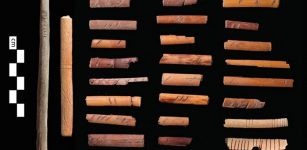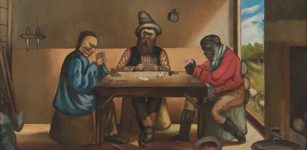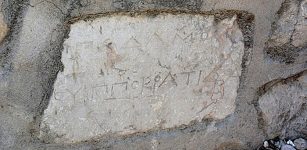Runic Inscription On The Forsa Ring Is Not What We First Thought – Scientists Say
Jan Bartek - AncientPages.com - The Forsa Ring, also known as Forsaringen in Swedish, is an iron artifact originating from Hälsingland, Sweden, dating back to the 9th or 10th century. Recent scientific analysis has led to a new interpretation of its runic inscription, shedding light on previously unknown aspects of Viking Age society.
The Forsa Ring is an iron ring from Hälsingland, dated to the 9th or 10th century. The runic inscription on the ring describes fines for a specific offense, where payment was to be made in the form of oxen and silver. On the picture a copy of the ring, stored in Forsa kyrka, Hälsingland. Photo: Ulrika Eriksson/Svenska kyrkan
This artifact is significant as it represents the oldest documented value record in Scandinavia, offering valuable insights into the monetary system of the Viking era. The inscription reveals how Vikings managed fines in a practical and adaptable manner, demonstrating a sophisticated approach to economic transactions.
The findings come from a study by researchers at Stockholm University's Department of Economic History and International Relations. Their work, published in the Scandinavian Economic History Review, provides a fresh perspective on Viking Age economic practices and social structures.
In their study, the researchers explain that the runic inscription on the ring provides valuable information about historical legal practices. It details fines for a specific offense, including oxen and silver payment options. This artifact is significant as it is currently recognized as Scandinavia's oldest preserved legal text. The ring is thought to have served a practical purpose as a door handle.
A recent reinterpretation of the Old Norse word "auk" has led to a revised understanding of the payment options. By changing the translation of the word "auk" from the previous interpretation "and" to the new interpretation "also," the meaning changes so that fines could be paid either with an ox or with two ore of silver. An ore was equivalent to about 25 grams of silver.
“This indicates a much more flexible system, where both oxen and silver could be used as units of payment. If a person had easier access to oxen than to silver, they could pay their fines with an ox. Conversely, if someone had silver but no oxen, they could pay with two ore of silver,“ says Rodney Edvinsson.
“The Forsaringen inscription "uksa … auk aura tua" was previously interpreted to mean that fines had to be paid with both an ox and two ore of silver. This would imply that the guilty party had to pay with two different types of goods, which would have been both impractical and time-consuming,“ says Rodney Edvinsson, Professor of Economic History at Stockholm University, who conducted the study.
The recent analysis indicates that the Viking civilization employed a dual payment unit system, using oxen and silver. This concurrent use of multiple units of account reduced transaction complexity and facilitated the fulfillment of financial obligations. Professor Rodney Edvinsson argues that this interpretation aligns better with the system's implementation in subsequent regional legislation. Furthermore, this finding is significant for understanding Scandinavian and European monetary history.
Old ink drawing of the Forsa ring. Creative Commons CC0 License. Photo: Lars Kennerstedt/the Swedish National Heritage Board
“As an economic historian, I mainly look for historical data to be economically logical, that is, to fit into other contemporary or historical economic systems. The valuation of an ox at two ore, or 50 grams of silver, in 10th-century Sweden resembles contemporary valuations in other parts of Europe, indicating a high degree of integration and exchange between different economies,“ says Rodney Edvinsson.
He has previously contributed to developing a historical consumer price index extending back to the 13th century, but this new interpretation provides insights into price levels even earlier in history.
See also: More Archaeology News
“The price level during the Viking Age in silver was much lower than in the early 14th century and late 16th century, but approximately at the same level as in the late 15th century and the 12th century, when there was a silver shortage,“ says Rodney Edvinsson.
The study emphasizes using modern economic theories to interpret historical sources. Combining economic theory with archaeological and historical findings enhances interdisciplinary research and deepens understanding of early economic systems.
The study was published in the Scandinavian Economic History Review
Written by Jan Bartek - AncientPages.com Staff Writer






















